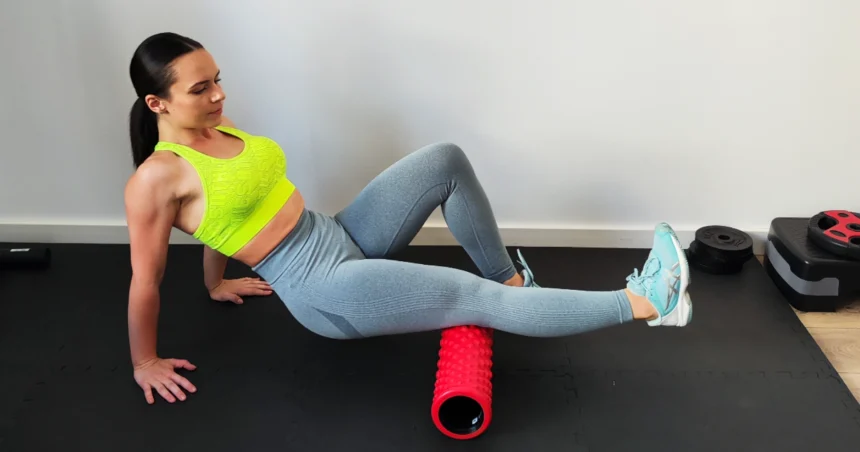Diving headfirst into the fitness world, you’ve probably stumbled across the term “foam rolling.” It’s not some new-aged yoga trend, but rather a self-myofascial release (SMR) technique. In layman’s terms? It’s a self-massage method to stretch and soothe tight, inflamed muscles.
Riding the wave of popularity in recent years, foam rolling has become a go-to for athletes and desk jockeys alike. The tool’s magic lies in its ability to relieve muscle tightness, ward off soreness, and calm inflammation. It’s a little like having a personal masseuse on standby 24/7, except this one doesn’t charge by the hour. Stay tuned to learn more about its core benefits and how to roll safely.
Core Benefits of Foam Rolling
Ready to roll? Here are the perks you’ll be signing up for.
Massage-Like Advantages
Just as a masseuse kneads away your tension, so does foam rolling. It targets and unties those pesky knots in your muscles. By doing so, it not only alleviates muscle tension but also enhances blood flow. It’s like inviting an increased supply of nutrients and oxygen to your muscle party. The result? Less soreness and a faster recovery time.
Daily and Versatile Use
What’s cool about foam rolling is that it’s suitable for any muscle group. Whether it’s your back screaming for some TLC after a long workday or your legs feeling the burn post-run, this handy tool has got your back. And your legs. And your arms. You get the idea. Consistency is key here. The more you roll, the better you’ll feel.
Workout Companion
Many gym enthusiasts swear by foam rolling as part of their workout routine. It’s an excellent pre-training buddy, reducing muscle tension and boosting circulation. This means you’re less likely to strain something while lifting that barbell. After a workout, it’s there to help ease muscle soreness and rigidity, like a reliable cool-down partner.
Psychological Benefits
But the benefits aren’t merely physical. Rolling can also be a psychological salve, helping to ease the day’s stress. You might even find that a quick roll before bed improves your sleep quality, as the physical release can translate to mental relaxation.
Muscular Health
Beyond temporary relief, foam rolling contributes to overall muscular health. It aids in alleviating long-standing muscle pain, amplifies performance, and cranks up flexibility. Over time, you may find that your range of motion has improved, and those hard-to-reach yoga poses aren’t so hard-to-reach anymore.
Associated Risks of Foam Rolling
Though foam rolling is pretty amazing, it’s important we don’t gloss over the potential risks. Let’s dig into those now.
Injury Complications
First up, if you’ve recently suffered a serious injury like a muscle tear, hit the brakes. Using a foam roller on injured muscles without getting a green light from a healthcare provider can lead to complications. Your body needs time to heal, and foam rolling might be too intense for the recovery process. As the old adage goes, “Don’t add insult to injury.”
Specific Joints Caution
Next, let’s talk about your joints. Ankle, knee, and elbow joints are delicate areas that need to be treated with care during a foam rolling session. Rolling directly over these joints could potentially lead to hyperextension, causing more harm than good. So, remember, it’s all about muscle tissue and fascia, not joints.
Discomfort Zones
Finally, be prepared for some discomfort, particularly in overly stiff regions. If you’ve been neglecting certain muscle groups, they might protest when the foam roller comes a-calling. But discomfort is different from pain. If you feel sharp, persistent pain, it’s a sign to stop and check in with a healthcare professional.
Best Practices and Precautions
So, you’re sold on the foam rolling idea. Here are some top tips to roll like a pro.
Safe Rolling Routine
First off, start slow. Rome wasn’t built in a day, and neither will your perfect foam rolling routine. Focus on gradual progress. Begin with shorter, less intense sessions and slowly build up as your comfort level increases. And remember, it’s not a race. Spend at least a minute on each muscle group to allow for thorough release.
Consultation is Key
If you’re dealing with existing injuries or medical conditions, always prioritize a consultation with your healthcare provider. This goes double for those new to the world of foam rolling. A healthcare provider or a certified fitness professional can guide you in crafting a safe and effective foam rolling routine that aligns with your health and fitness goals.
Final Thoughts
As with any health practice, foam rolling is a mixed bag of benefits and risks. On the sunny side, it can ease muscle tension, boost circulation, improve flexibility, and even help destress. But proceed with caution. Remember to roll responsibly, particularly around joints, and seek medical advice for serious injuries. Ultimately, make an informed decision that respects your body and your wellness journey. Happy rolling!









